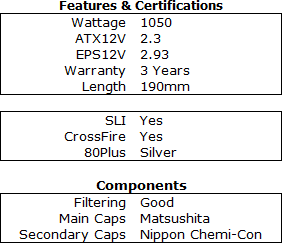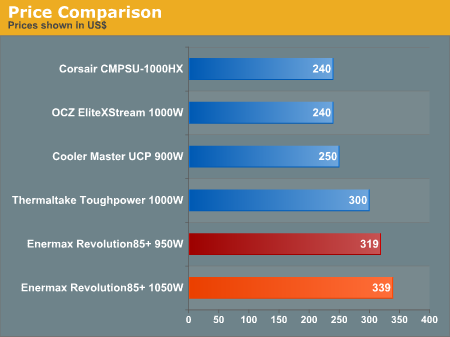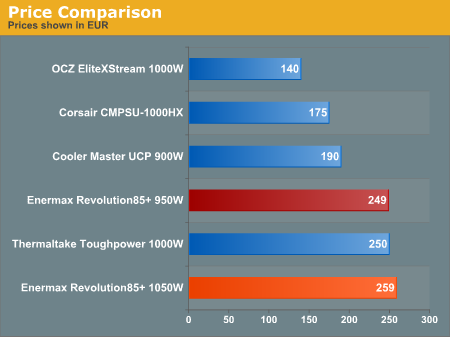Enermax Revolution 85+ High Efficiency PSU
by Christoph Katzer on November 6, 2008 4:15 AM EST- Posted in
- Cases/Cooling/PSUs
Conclusion
Our expectations for this power supply were very high, but we are happy to say that it met its potential in every way. Beauty as always is in the eye of the beholder, but we do like the appearance of the Revolution 85+. The original sample was far more conservative in its design, and when Enermax told us they were revising the look we didn't think it was necessary, since it would probably just increase the price. However, we have to say that the final result does look really cool. The combination of the black textured surface with the red highlights around the fan grille is very attractive in our opinion.
The feature list is similarly impressive, even though most users will not see or recognize some of the innovations. Enermax included a lot of new technologies in this power supply, and the results are very good. It starts with a good topology that lets the two transformers act in synchronization. Another nice feature is the DC-to-DC circuitry that increases efficiency. The not new but still good addition of the 12-pin sockets on the front of the power supply give potential support for future connector developments -- provided of course that the voltage requirements don't change.
The length of the ATX and PEG cables is long enough for most systems. However, if you want to install this power supply in a case where the PSU is in the top rear and the hard drives are in the bottom front, you may have some difficulties getting the cables to reach. Likewise, if the PSU sits in the bottom of your case you might not be able to route all of the cables nicely through the chassis but will have to take a more direct path. The eight 6/8-pin PEG connectors are very nice and make this power supply ready for any GPU configuration all the way up to triple SLI and more. If you're going to use multiple graphics cards, this PSU will likely work best in a bottom-mounted location.
Build quality has never been a concern with Enermax products. About the only problem we've ever encountered were some incompatibilities in the past with a few specific motherboards. Those issues never occurred with higher end PSUs, however, and the Revolution 85+ is clearly the highest of their high-end power supplies. They have included all of the best features from their previous offerings, plus a few new ones for good measure. All of this adds up to the tremendous performance we saw today.
Voltage regulation was good and not even our 10% overload test could cause this unit to sweat. The efficiency is the best we have seen from any previous power supply to date. Enermax states on the package that up to 90% efficiency is possible, and we achieved exactly that with 230VAC. Even with a lower 120VAC input, efficiency still reached an incredible 88%. As mentioned, optimal efficiency generally requires a minimum load of 200W; if you have a system that idles above 200W, you won't need to worry about power supply efficiency for a long time.
Another nice feature is the no load function. As we hinted at earlier, we loaded the power supply using only the 12V rails, keeping the lower voltage 3.3V and 5V rails load-less. We had no trouble at all pulling up to 1000W on the 12V rails without any lower voltage rails, and the PSU still maintained a very nice regulation of just a few millivolts under 12.00V. Of course, with a DC-to-DC circuit the power supply has no total combined power anymore. For reference, when we tried this test on other power supplies, they immediately shut down when either the 3.3V or the 5V rail didn't have any load.
 |
The heatsinks stayed very cool during testing, with temperatures lower than 40°C. Only after running at 110% for a longer period of time did we manage to get heatsink temperatures above 40°C. The fan speed begins increasing with 500W of load and actually lowers temperatures slightly for a while; it's only from 1050W onwards that the heatsink temperatures rise again and the fan can't quite keep up. The drawback is that noise levels are slightly higher than the temperatures warrant; we measured only 29dB(A) under highest load which is still an extraordinary result, but it should have been possible to keep noise levels down even further since the heatsinks aren't that hot at all. Still, it's always better to have a cooler running power supply than to toe the line, which is why Enermax regulates temperatures and fan speeds in this fashion. Keeping the internals at around 40°C at all times is not at all a bad approach, and this should increase the lifespan for this power supply.
Let's compare this unit to other 1000W units and see where it fits. Let's start with the Cooler Master UCP, since there are similarities with the Enermax Revolution 85+. The Revolution 85+ comes with about the same amount of cables and connectors. The PEG connection options are similar but the UCP has them further from the PSU, which is better for users since that provides for better cable routing options. However, Enermax has six 6/8-pin PEG connectors, giving the user greater flexibility. The Corsair HX1000W is also very similar. Compared to units from our 1000W roundup last year, the Enermax Revolution 85+ outperforms all of them. There are more connectors on power supplies now, since manufacturers have discovered that they have plenty of headroom. Power supplies also sport 6/8-pin connectors as well rather than just providing 6-pin PEG, which is a good addition.
In voltage distribution, we don't see really much difference between the Revolution 85+ and many of the competing units tested this year. The Corsair HX1000W has a very good regulation as well, so the Enermax unit has no advantage in this regard. However, when it comes to efficiency there's not much to compare -- after all, we already said the Revolution 85+ is the most efficient power supply we have tested to date. The HX1000W achieves up to 86% and the Cooler Master UCP is close with up to 89% efficiency. This brings Cooler Master back into the game, but if we compare all the additional features (i.e. safety and protection) Enermax leaps ahead again.
The final comparison is pricing. Since each "revolutionary" product that enters the market is usually more expensive than the preceding units, we are not expecting wonders here. We'll let the numbers do the talking:


As expected the MSRP for both units we listed is far above everyone else in the U.S. The Corsair HX1000W is similarly equipped with connectors and offers a wide range of features as well. For a price of around $240 it is a true bargain compared to the others in the list. Still, the Enermax Revolution 85+ offers more and we need to keep in mind that we are using MSRP for now -- street prices will almost certainly be lower. In Europe OCZ sells its EliteXStream for an extremely low price of only 140€, but the others all come close to the Enermax MSRP. Prices should also drop as availability improves, though Enermax will keep it above a certain level as we have seen with the Galaxy series. Enermax knows its advantages over the competition and that will result in prices that should stabilize slightly higher than competing products.
 |
Even though these power supplies are anything but cheap, we are confident in making the statement that the Enermax Revolution 85+ is currently the most advanced consumer power supply available. It offers exceptional efficiency, voltage regulation, temperatures, and has very good build quality. It doesn't necessarily surpass the competition in every area, but it's always at the top of the charts. Ultimately, the innovations, feature set, and performance impress us so much that we are pleased to award the Enermax Revolution 85+ our Gold Editors' Choice Award. It's entirely possible that if you purchase the 1050W model, you could end up running the same PSU for the next couple of presidential elections -- and you can do so knowing your PC will be as green as a hybrid SUV.










49 Comments
View All Comments
houe - Thursday, November 6, 2008 - link
Seems odd to have a "efficient" 1000 watt computer. If you care about low power I doubt you'll be putting a 1000 watt supply in your rig. Any computer that consumes 200 watts at idle is probably not a computer you'll want to run 24/7 so the efficiency probably isn't going to matter too much. That being said it still seems like a cool power supply.Rezurecta - Thursday, November 6, 2008 - link
Thank you for the dumbest comment ever.MadMan007 - Thursday, November 6, 2008 - link
I don't think it was dumb and certainly not the dumbest comment ever. He asked why they start at 800W (should have said 850W but whatever) and he's right about the real power draw of systems. Having super high power PSUs is fine but I'd love to see efficiency like this starting with a 400-500W unit not 850W. A mega-PC is going to draw lots of power anyway. The 82+ line does fill the lower power draw range, maybe that's why they started this higher, but that doesn't make the question dumb.Christoph Katzer - Thursday, November 6, 2008 - link
People just need to understand that at the moment it's just still too expensive to build units around this wattage that have 90%+ efficiency. You don't wanna pay $150 for a 500W PSU because you can run your normal one for years and ending up with the same price.MadMan007 - Thursday, November 6, 2008 - link
Fair enough, at least that's a reason and not saying 'dumb comment' :) The 82+ line is nearly as efficient and does have some low power options so Enermax may feel they already have that segment filled.Over time the design changes that increase efficiency should trickle down yea?
Rezurecta - Thursday, November 6, 2008 - link
That was for iwodoThe0ne - Thursday, November 6, 2008 - link
I'm not sure you know what YOU'RE talking about making that comment to Iwodo, unless of course you prefer to stick to your configuration that requires more than 850W. In which case, carry on.700W for my configuration.
IP35 Pro with Q6600@3.2GHz, 4Gig, 9800GX2, 2 DVDRW, 5 Hard Drives, 6 internal Fans for the case, misc USB devices
So I don't know about you but I think his question is very valid. The dumbest I think would be someone who came up with the question afterward not thinking more about what the other person was addressing.
legoman666 - Thursday, November 6, 2008 - link
Lol, you're out of your mind if you think your system uses anywhere near 700w. Buy a Kill-A-Watt and report back some real usage numbers. I imagine it's closer to 300-350w @ full load.gochichi - Monday, November 10, 2008 - link
I know right? I've been "bad" and left my little Inspiron 530 with the power supply that came with it and I'm running a Radeon 4850 (fairly power hungry, but not wacko hungry) in it and it runs perfectly. At most it's rated at 350W and it's a Quad-core system with some other goodies.The way I see it, burning DVDs, playing Blu-rays, playing games are some of the most energy consuming things you can do. However, you do either one or the other. I'm sure my system would have power issuues if I played Crysis, burned DVDs and watched a blu-ray all at one time. But you know what? My system, though it's beefy can't handle those things at one time anyway, so who cares.
This powersupply is super nice though. Over the top? Yes. But it's so nice it just doesn't matter. This guy is for systems running Raptors and X-fire and all that stuff. Even if you're not running that stuff though, it's perfectly quiet at loads of 500W or below. So even when you're not pushing it, it's still classy. It's like a Corvette cruising at 65MPH, it's still awesome.
Big thumbs up to this power supply. Expensive junk is bad, but really good stuff for $300.00 is alright by me. Not for me, but if you own it... I'm kind of jealous.
The people at the top end have to have a power supply, and I think this is it for them.
The0ne - Friday, November 7, 2008 - link
The 9800GX2 video card alone already requires a minimum of 580W. How am I out of my mind for paying heed to the requirements? Do you mean to implied that I'm a sucker for believing all power supply ratings and I should instead do my own measurements when finding a power supply? Tell me, do you do this when selecting your own components?The only reason I bought the 700W was because my Nfinity 600W was not efficient enough to run the system after I installed the video card. So while the power efficiency might be low, I still need a ADVERTISED power supply of 700W+
Maybe you're psychic?